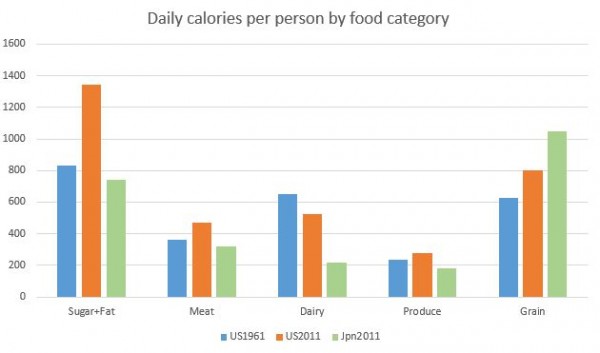
By Dr Alan Viau
For years we have been bombarded with news items declaring obesity and diabetes as epidemic in our North American society. And it is true. Our society has hit all-time highs in recording of health problems related to these two conditions. A myriad of solutions have been proposed – from fad diets, exercise, to supplements and meditation. It makes you wonder what the real the cause of our problems is.
Science is increasingly pointing to the fact that we over consume. We bring in more calories than we burn. Our eating habits is what is killing us.
A came across an older yet still relevant article in the National Geographic called What the World Eats. It compares the diets of 22 countries. It maps out what the diets are comprised of and how they have changed over 50 years.

Calories per day by food category. Data from http://www.nationalgeographic.com/what-the-world-eats/
If you examine the data for the United States, there are some striking observations. From 1961 until 2011, the average US daily consumption of calories has increased from 2882 to 3641 – that’s 759 calories for an over 25% increase. The increase was in all food categories – meat, dairy, grain, sugars… and even vegetables.
To put the increase in context, it is like eating over 8 more scrambled eggs per day! Eight more eggs wouldn’t be too bad as they are a good source of protein. However, the highest increase is in the consumption of sugars and vegetable oils – a whopping 60% growth. Sugar is now so pervasive in our diet that a new report shows that two thirds of our foods contain added sugar.
The World Health Organization and Heart & Stroke now recommend that people limit their sugar intake to no more than 10 per cent of overall calories, or about 12 teaspoons a day. The National Geographic data shows that we North Americans consume 15 per cent of our calories as sugars.
There are stories that compare various diets, declaring some healthier than others. The diet of Japan is often mentioned as one of the best in the world. It is therefore worth comparing the US diet composition to Japan’s. In 2011, the average Japanese calorie intake was 2717. This is about the same calorie intake as was recorded for the average American in 1961. This clearly shows that consumption alone is a major contributor to the weight problem.
The Japanese diet differs in other ways from the US one. Japanese eat more rice, fish and less dairy. Americans eat mostly poultry, more dairy and mostly wheat as a grain source. These differences could contribute to other health factor such as the increase in gluten intolerance but that has yet to be fully substantiated.
The message is quite clear. Over consumption in all food categories, but especially sugars, is the reason for our growing obesity and diabetes problem. So don’t eat more vegetables. Eat less of everything and substantially reduce your sugar intake.



